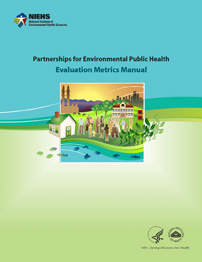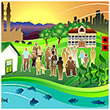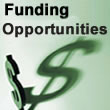Partnerships for Environmental Public Health (PEPH)
Program Lead
-

-
Liam R. O'Fallon, M.A. (http://www.niehs.nih.gov/research/supported/dert/sphb/staff/ofallon/index.cfm)
Program Analyst -
Tel (919) 541-7733
Fax (919) 316-4606
ofallon@niehs.nih.gov -
P.O. Box 12233
Mail Drop MD K3-12
Research Triangle Park, North Carolina 27709
Delivery Instructions
Program Description
PEPH is a network of scientists, community members, educators, healthcare providers, public health officials, and policymakers who share the goal of increasing the impact of environmental public health research at the local, regional, and national level. PEPH defines environmental public health as the science of conducting and translating research into action to address environmental exposures and health risks of concern to the public.
Grantees: for information on how to access the PEPH Resource Center, please contact Liam O'Fallon or Lynn Albert. You can also visit the NIEHS Research Partners page ( http://partners.niehs.nih.gov/ ) to access the Resource Center and other NIEHS shared datasets and applications.
PEPH Partner at the University of Arizona Honored with Public Communication Award
Communication with the public is a major component of many activities among our PEPH partners. This year, the Public Communication Award of the Society of Toxicology (http://www.toxicology.org/) will be presented to one of our partners, Marti Lindsey, Ph.D. (http://swehsc.pharmacy.arizona.edu/outreach) , director of the Community Outreach and Education Core (COEC) (http://swehsc.pharmacy.arizona.edu/outreach/overview) at the Southwest Environmental Health Sciences Center (http://swehsc.pharmacy.arizona.edu/) . The award recognizes her major contributions to increasing public awareness about toxicological issues through public communication with a focus on raising environmental health literacy (http://swehsc.pharmacy.arizona.edu/outreach/community-environmental-concerns) .
The fruits of her leadership and COEC efforts are evident in the range, scope, and number of programs and materials that are offered by the COEP. They offer workshops and summer camps for teachers, students, and community groups. A wealth of K-12 educational curricula, lesson plans, PowerPoint presentations, and activities are available online (xxx) .
As an example of their public outreach portfolio (http://coep.pharmacy.arizona.edu/programs/index.html) , "Air Info Now" (http://coep.pharmacy.arizona.edu/air/index.html) offers real-time air quality and interactive materials accessible to the public. Learn about changes in carbon monoxide levels and the air quality index depending on the time of day and air temperature, or expose a set of lungs to different air pollutants.
The award will be presented at the upcoming Society of Toxicology Annual Meeting (http://www.toxicology.org/ai/meet/am.asp) in March.
Numerous Flame Retardants in House Dust, Some Exceeding Federal Health Guidelines
Recent studies from our PEPH partners have shed light on concerns for widespread exposure to flame retardants in U.S. homes, and their publications garnered a flurry of attention in the press. Flame retardants (FRs) are commonly used in furniture and other products, and pose health risks including cancer, learning problems, and hormone disruption.
In a new report (http://pubs.acs.org/doi/pdfplus/10.1021/es303879n) published in Environmental Science & Technology, Robin Dodson, Sc.D. (http://www.silentspring.org/about-us/staff#robin) , at the Silent Spring Institute (http://www.silentspring.org/) found that, in a survey of house dust, 36 of 44 FRs identified were detected in at least 50% of the samples. Most houses tested had at least one FR in house dust whose levels exceeded a federal health guideline.
In the same issue, Heather Stapleton, Ph.D. (http://fds.duke.edu/db/Nicholas/esp/faculty/stapleto) , an environmental chemist at Duke University Superfund Research Program (http://sites.nicholas.duke.edu/superfund/) , published study (http://pubs.acs.org/doi/pdf/10.1021/es303471d) findings that over 85% of couches tested contained an FR. Stapleton said, "Our study found that one California state flammability standard is affecting the entire country's exposure to chemicals that may be causing human health problems, and it is unclear whether or not these chemicals actually offer any fire safety benefits." Dodson added, "These hazardous chemicals are in the air we breathe, the dust we touch, and the couches we sit on. Infants and toddlers who spend much time on the floor are at higher risk for exposure." Their research received much publicity in the press including Forbes (http://www.forbes.com/sites/alicegwalton/2012/11/28/the-chemicals-in-your-couch-may-pose-serious-health-risks/) , Nature (http://www.nature.com/news/cancer-causing-flame-retardants-linger-on-in-california-1.11910) , CBS (http://www.cbsnews.com/8301-204_162-57555975/harmful-flame-retardants-found-in-84-percent-of-calif-couches/) , San Francisco Chronicle (http://www.sfgate.com/health/article/Chemicals-in-furniture-hard-to-avoid-4072857.php) , and the Chicago Tribune (http://articles.chicagotribune.com/2012-11-27/news/ct-met-flames-couches-20121128_1_flame-retardants-heather-stapleton-california-at-berkeley-chemist) . The Silent Spring Institute offers a factsheet (http://silentspring.org/tip-sheet-5-tips-reduce-toxic-flame-retardants-home) with suggestions on how you can reduce exposures to FRs in your home.
Pestibytes Podcast Series Discusses Common Pesticide Questions

How can I wash pesticides from fruit and veggies? Can bug bombs really explode? With a baby on the way, is it okay to spray? These and seventeen other common pesticide questions are discussed in a podcast series called Pestibytes (http://npic.orst.edu/pestibytes/index.html) . The series was created under a cooperative agreement between Oregon State University Superfund Research Program, the National Pesticide Information Center (NPIC), and the U.S. EPA (cooperative agreement #X8-83458501). The short podcasts feature NPIC specialists offering information. Transcripts of the podcasts are also posted on the website.
For additional materials please refer to the PEPH materials page.
 (http://www.niehs.nih.gov/research/supported/assets/docs/a_c/complete_peph_evaluation_metrics_manual_.pdf)
(http://www.niehs.nih.gov/research/supported/assets/docs/a_c/complete_peph_evaluation_metrics_manual_.pdf)
The PEPH Evaluation Metrics Manual (http://www.niehs.nih.gov/research/supported/programs/peph/metrics/index.cfm) provides examples of tangible metrics that PEPH grantees and program staff can use for both planning and evaluation. Example logic models are used as a means to develop evaluation metrics for cross-cutting PEPH themes such as Partnerships, Leveraging, Products and Dissemination, Education and Training and Capacity Building. PEPH grantees (including all project partners) are the primary target audience for this document.
Current Issue of the PEPH eNews (http://tools.niehs.nih.gov/pephnews/lists/currentissue.cfm)
 (http://www.niehs.nih.gov/research/supported/dert/sphb/programs/peph/podcasts/index.cfm)
As we think about the future of environmental public health, we must start with our youth and tap into their passion and thirst for knowledge. Together, we have a role in guiding them and strengthening their skills to participate in the full research process. In this issue, we feature a number of reports on youth-centered activities and resources. Keep up with the youth by checking out ways to brush-up on your social media skills and communication technologies. You can start by following @NIEHS_PEPH (http://twitter.com/NIEHS_PEPH) on Twitter!
(http://www.niehs.nih.gov/research/supported/dert/sphb/programs/peph/podcasts/index.cfm)
As we think about the future of environmental public health, we must start with our youth and tap into their passion and thirst for knowledge. Together, we have a role in guiding them and strengthening their skills to participate in the full research process. In this issue, we feature a number of reports on youth-centered activities and resources. Keep up with the youth by checking out ways to brush-up on your social media skills and communication technologies. You can start by following @NIEHS_PEPH (http://twitter.com/NIEHS_PEPH) on Twitter!
New Environmental Health Chat Podcasts
PEPH launched a new monthly podcast series called Environmental Health Chat (http://www.niehs.nih.gov/research/supported/dert/sphb/programs/peph/podcasts/index.cfm). Each short episode highlights ways researchers work in partnership with community groups to understand and address environmental health issues. Four podcasts are now available, including one on school siting to protect children's health (http://www.niehs.nih.gov/research/supported/dert/sphb/programs/peph/podcasts/school/index.cfm).
Time-Sensitive Grant Opportunity: Sandy's Impacts on Public Health
The NIEHS is offering a grant opportunity (http://1.usa.gov/WduwCI) with a deadline of February 20, 2013. Applications should focus on novel questions of public health importance related to exposures and/or health effects in the aftermath of Hurricane Sandy.
PBS Learning Media Offers Environmental Public Health Lessons
PBS LearningMedia (http://www.pbslearningmedia.org/) , an online resource for educational materials, recently posted an "Environmental Public Health" (http://www.pbslearningmedia.org/collection/enh/) collection. These free modules were developed with funding from the NIEHS. Climate change, PCB cleanup, and environmental justice are examples of over 50 topics covered in videos and activities for grades K–12.
Social Media/Technology Resources for Science Communication
A wide range of cutting-edge social media and technology tools can enhance your communication of scientific information to a wide range of audiences. Naomi Hirsch at Oregon State University Superfund Research Program (http://oregonstate.edu/superfund/home) spearheaded a website, "Web and Emerging Technology Resources for Scientists" (http://oregonstate.edu/superfund/apha-roundtable-communication-strategies#.UPmAnvLnOAh) that lists numerous resources for networking, data visualization, mapping, and more.
Webinar on Initiatives with Mobile Technology
Learn about federal efforts to advance public health initiatives with mobile technology. NIH experts will discuss the development and use of new technologies as well as policy considerations of mobile medical applications. February 13, 2013 from 9:00–10:00 a.m. ET. Register online (http://www.icfi.com/healthforum?mkt_tok=3RkMMJWWfF9wsRons63LZKXonjHpfsXw6ektWrHr08Yy0EZ5VunJEUWy2oEGSdQhcOuuEwcWGog8yQ9eE%2B6BeZJO%2B%2BFUBE%2BzVA%3D%3D) .
Upcoming PEPH-related Meetings
- March 1-2, 2013: "Gulf of Mexico Environmental Justice Conference (http://epa.gov/gmpo/) " in Biloxi, Mississippi.
- March 3-6, 2013: "Environmental Health 2013: Science and Policy to Protect Future Generations (http://www.environmentalhealthconference.com/index.html) " in Boston, Massachusetts.
- March 7-9, 2013: "Improving Medical Effectiveness and Health Outcomes to Achieve Health Equity Through Interprofessional Collaborations (http://xula.the1joshuagroup.com/index.html) " in New Orleans, Louisiana.
- March 10-14, 2013: "Society of Toxicology Annual Meeting (http://www.toxicology.org/ai/meet/am.asp) " in San Atonio, Texasn.
- March 15, 2013: "5th Annual NW Environmental Health Conference (http://www.oeconline.org/our-work/healthier-lives/healthprofessionals/2013-5th-annual-nw-environmental-health-conference/call-for-presenters-at-the-2013-nwehcn) " in Portland, Oregon.
- July 29–31, 2013: "Environmental Health Disparities and Environmental Justice Meeting (http://www.niehs.nih.gov/research/supported/dert/sphb/programs/peph/events/) " in Research Triangle Park, North Carolina.




